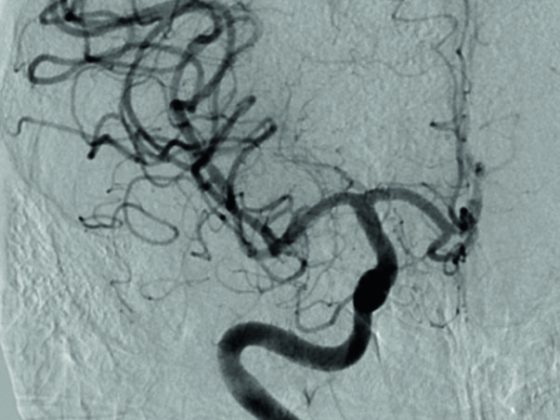In June 2015, the Swiss PostASCO Meeting took place in Bern – the ideal event for all those who cannot or do not want to attend the ASCO Congress in the USA, but would still like to learn about the news conveyed there. In half-hour lectures, opinion leaders from Switzerland presented the latest studies in the individual areas of oncology. We report some key findings.
The MET pathway is one of the most important molecular genetic markers in gastric cancer. Overexpression of MET is found in approximately 60% of patients. In a phase II trial, overall survival (OS) and progression-free survival (PFS) had been shown to improve in patients with MET-positive gastric cancer when treatment was supplemented with the antibody rilotumumab, an inhibitor of the MET pathway.
Disappointing results of the RILOMET-1 study
In the RILOMET-1 trial (phase III) now presented, involving approximately 600 study participants with MET-positive em gastric cancer, half of the patients received rilotumumab or placebo in addition to ECX chemotherapy (epirubicin, cisplatin, capecitabine) [1]. The primary endpoint was OS. The study had to be stopped because significantly more deaths occurred in the verum group than in the placebo group (128 vs. 107). OS and PFS were lower in the rilotumumab group than in the placebo group, and the antibody also showed no beneficial effect in the patient subgroups with the greatest MET expression. In addition, side effects such as peripheral edema, hypoalbuminemia, and deep vein thrombosis increased during treatment with rilotumumab.
Another study (METgastric) conducted with the MET inhibitor onartuzumab in over 500 patients with HER2-negative umd MET-positive gastric cancer also showed a negative result [2].
The conclusion: inhibition of the MET pathway does not appear to have a beneficial effect in gastric cancer.
Immunotherapy in gastric cancer: encouraging results
More reason for hope was provided by the KEYNOTE trial, in which patients with PD-1-positive advanced gastric cancer (40% of patients screened) were treated with the antibody pembrolizumab [3]. 67% of patients had already received two or more therapies for advanced gastric cancer. The objective response rate (ORR) was 22-33%, and the response lasted a median of 24 weeks (range: 8-33 weeks). PD-1 expression was associated with ORR. PFS at six months was 24%, and OS at six months was 69%. Based on these positive results with longer lasting remissions, we are now looking forward to the next data from the KEYNOTE study.
In patients with advanced or metastatic pancreatic neuroendocrine tumors (pNET), a phase II trial tested the combination of everolimus (mTOR inhibition, proven efficacy in NET) and bevacicumab (VEGF inhibitor) [4]. Each of 75 patients received either everolimus alone or the combination therapy. Response rates (31 vs. 12%) and PFS (16.7 vs. 14 months) were increased in the combination therapy group, but significantly more toxicities occurred, including diarrhea, hyponatraemia, proteinuria and hypertension. At best, it is better to give the two agents sequentially than combined because of this risk of toxicities.
Endometrial cancer: improved therapy…
In the MITO-END-2 study by Lorusso et al. bevacicumab (Bev) was studied as an adjunct to carboplatin-paclitaxel (CP) therapy in patients with advanced endometrial cancer [5]. Fifty-four patients each received CP alone or a combination of CP and Bev (CP-B). In the verum group, thromboembolic events and cardiotoxicity were significantly more frequent, but PFS improved from an average of 8.7 (CP) to 13 months (CP-B), and the response rate was also significantly higher (54.3 vs. 72.7%). These encouraging results are now being tested in a Phase III trial.
… but lower quality of life
The PORTEC-3 trial is testing whether patients with high-risk endometrial cancer might benefit from adjuvant chemotherapy during or after radiation. Initial results regarding toxicity and quality of life were presented at this year’s ASCO congress [6].
A total of 674 patients participated in the study; they received either radiotherapy alone (RT) or radiotherapy in combination with chemotherapy (CTRT). Side effects were significantly more frequent in the CTRT group, mainly hematologic, neurologic, and gastrointestinal symptoms. Quality of life was also lower in this group of patients – but mainly in the first months after therapy. During the two-year follow-up, the quality of life recovered, and after this time the CTRT patients did not differ from the RT patients with regard to side effects.
Prolonged survival in metastatic sarcoma
Doxorubicin has been the standard therapy for sarcomas for 40 years. This is unlikely to change in the near future, but there is evidence of combination therapies that may improve the prognosis of sarcoma patients. In an unblinded phase II study, olaratumab, a monoclonal antibody, was tested in combination with doxorubicin for the treatment of unresectable resp. metastatic sarcomas reviewed [7]. Sixty-five patients received doxorubicin alone (D group), and 64 patients received the doxorubicin-oblatumab combination (K group). PFS was 6.6 months in the K group and 4.1 months in the D group. The difference in OS was even greater: It was 25 months in the K group, but only 14.7 months in the D group.
In the K group, however, toxicities also occurred more frequently. The following adverse events ≥Grade 3 occurred in more than 5% of patients overall and more frequently in the K group than in the D group: Neutropenia (51.5 vs. 33.8%) anemia (12.5 vs. 7.7%), fatigue (9.4% vs. 3.1%), and thrombocytopenia (9.4% vs. 7.7%); more common in the D group than in the K group were febrile neutropenia (13.8 vs. 12.5%) and infections (10.8 vs. 6.3%).
The 10.3-month improvement in median overall survival was highly statistically significant (HR=0.44; p=0.0005). For this reason, olaratumab received the FDA’s Breakthrough Therapy designation.
GIST: three years of treatment with imatinib
The reasonable duration of therapy with imatinib after resection of high-risk gastrointestinal stromal tumor (GIST) was investigated in the second analysis of the SSGXVIII/AIO trial (after a mean follow-up of 7.5 years) [8]. Each of 200 patients had received imatinib for one year or three years after surgery. Patients on imatinib therapy for three years showed both longer OS (93.4 vs. 86.8% at five years) and longer relapse-free survival. As a result, patients with high-risk GIST should receive imatinib for three years after tumor surgery.
Source:9th Swiss PostASCO, June 11, 2015, Bern
Literature:
- Cunningham D, et al: J Clin Oncol 2015; 33: suppl, abstr 4000.
- Shah MA, et al: J Clin Oncol 2015; 33: S3, 2.
- Yung-Jue B, et al: J Clin Oncol 2015; 33: suppl, abstr 4001.
- Kulke M, et al: J Clin Oncol 2015; 33: suppl, abstr 4005.
- Lorusso D, et al: J Clin Oncol 2015; 33: suppl, abstr 5502.
- Creutzberg C, et al: J Clin Oncol 2015; 33: suppl, abstr 5501.
- Tap W, et al: J Clin Oncol 2015; 33: suppl, abstr 10501.
- Joensuu H, et al: J Clin Oncol 2015; 33: suppl, abstr 10505.
InFo ONCOLOGY & HEMATOLOGY 2015; 14(5): 34-35.











